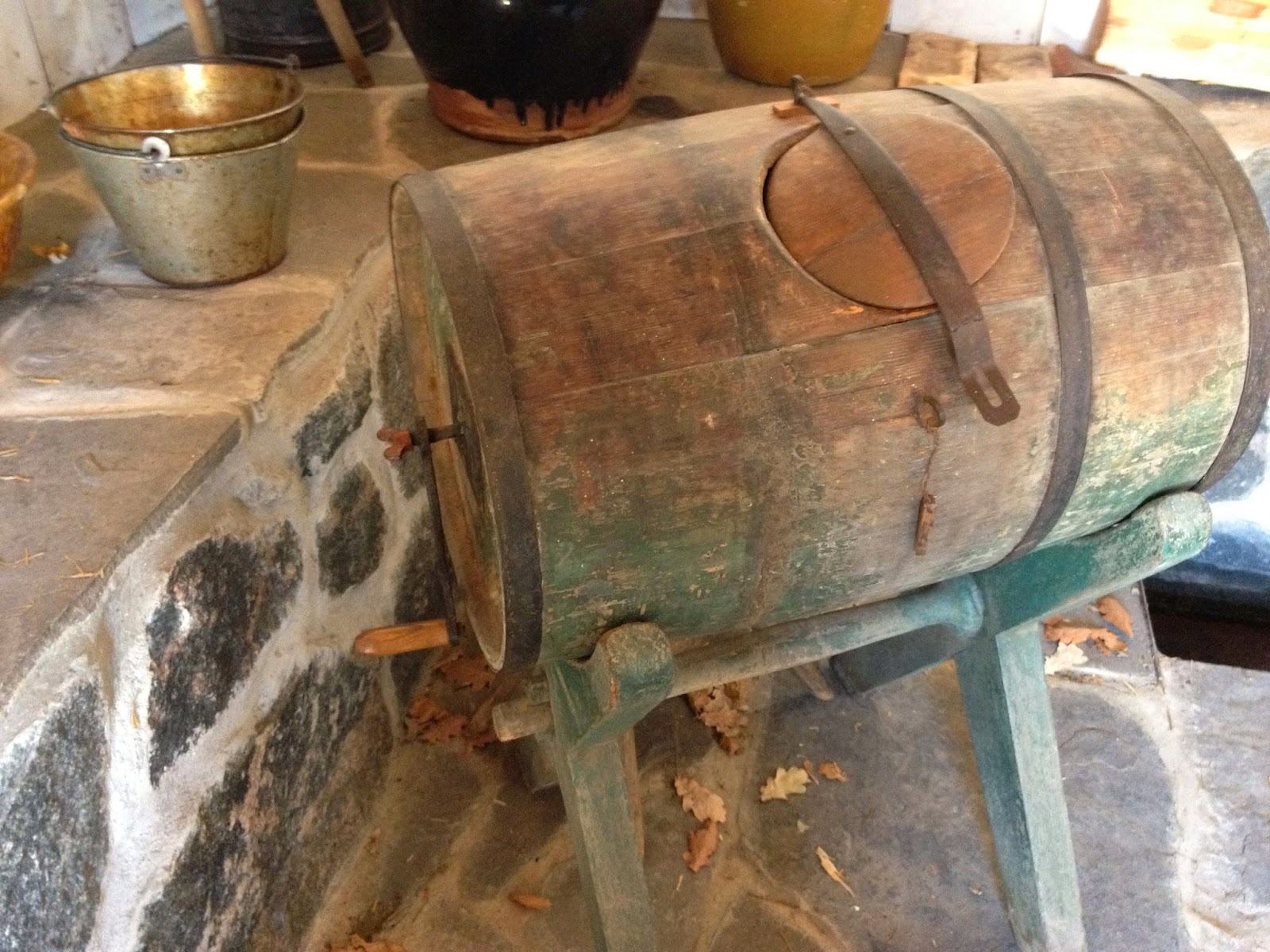Breakfast is a memory, the cows have been milked and now it is time to get on with the morning chores.Any fresh cream that is not going to be needed immediately will be poured into clean cream crocks, covered with pristine linen cloths and stored in the cool spring house.
The dairy cattle that were raised locally by the early Pennsylvania German pioneers did not produce the quantity of milk that we see in modern cows. Most often, fresh milk (cream!) was stored/collected for several days and kept cool in spring houses until it would have been churned into butter or made into a soft cheese that had many variations and uses (more on this in the next post). Butter making was very competitive and lucrative. As a commodity, butter was something that a proud farm wife would have been able to sell at a local market for a profit (small, perhaps, by today's standard but an attractive means to make some extra money for a woman who spent a great deal of her time on her family farm and had little opportunity to make money for herself).
The process of butter making was relatively simple but the process of making your mark in the cottage industry was anything but. At least until the middle of the 19th century (before the advent of the milch haus or milk house, the successor to the spring house that served the purpose of a creamery), butter was often made in the spring house, itself. Meticulously clean, many early spring houses contained two rooms and cream was often strained directly through cloth into earthenware vessels (sometimes small oak tubs that would hold a couple of pails of milk were substituted for the crocks). With the milk set into the crocks, the haus frau (farm wife) would wait at least a day to let the higher fat cream rise to the surface of the vessel. (Dairying was most often the realm of the woman on the farm). Once the cream had separated and risen, floating on top of the milk, a skimmer was used to skim off the precious cream where it would be carefully removed and placed into another earthenware crock where enough could be gathered until there was enough to churn into butter. Additionally, allowing time for the cream to rest for about 3 to 6 days before churning it was believed to produce a better final product=butter!
Ventilation was a crucial element to keep the air flowing and the temperature more or less cool and balanced, even in the summer months. In addition to a water channel through which a small section of cool spring water flowed freely, windows were opened as needed to ensure good air flow.
Dutch doors that could lock on the bottom but provided upper air flow were also commonly used:
After the ripening period, the cream was transferred to a churn where it would be agitated/churned into butter.
 |
| A dasher churn, seen on the left with its wooden "dasher" handle rising out of the metal base. A common design. Another popular churn design that was commonly used by the Pennsylvania Germans was the barrel churn that used a hand crank and interior paddle. Cream was placed in the top of the barrel and locked into place before the crank was turned. A relatively cleaner method than the dasher churn, some also believed that the barrel churn was faster, as well. The process of making butter was very competitive and not always an honest one. Sometimes the cream would spoil and unscrupulous individuals would attempt to churn and then sell the unsavoury product. The wise haus frau (farm wife) who took great pride in her work and investment would take great pains to establish her own brand or mark--often by imprinting her finished product before taking it to be sold. Word would quickly circulate if your reputation had been compromised for selling tainted butter. Wooden butter prints were intricately carved and were often quite beautiful, decorated in various folk motifs. On the table below are various small butter prints displayed beside wooden butter paddles, a heart-shaped cheese mold and a large wooden butter bowl. Folk motifs like acorns and leaves (above) or tulips (below) are lovely reminders of the great care taken to mark one's butter. My colleague, Kathleen, carefully cradles the dasher churn between her knees. It is a good idea to place a clean cloth on top of the churn so that splashes of cream will not get on your hands or your apron. Kathleen is focused on the work ahead but the work ahead will take at least a couple of hours. Vigorous, rhythmic up and down motion is needed to agitate the fat molecules in the cream. Finally, a delicate yellow ball of butter is separated from a clear liquid--the buttermilk. Traditionally, this buttermilk would have been a nutritious addition to a pig's food. Transferring the finished butter into a separate bowl where it will be pressed with a butter paddle to ensure that all liquid is out of the butter. It is at this point that one can add a light sprinkling of salt to flavour the butter. I have to say, fresh churned butter is absolutely delicious and tastes nothing like the store-bought kind! Finished butter, ready to be printed... The only thing missing is the bread (but that's another post)! Until then, why not check out: http://historyofbread.wordpress.com/ Coming Up: Keeping Things Cool in the 19th Century, Pt. 3: Making Cheese |
















